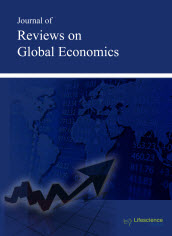jrge
Abstract - The Digitalization of the Russian Financial Market: The Use of Technologies of the Distributed Ledger by the Institutions of Custodian Infrastructure
|
|
Abstract: Over the past 30 years financial markets have moved from a highly centralized to a globalized system that includes all the world's stock exchanges and other financial institutions. The global stock architecture has united the world market. Keywords: Blockchain, financial market, custodian infrastructure, securities, distributed ledger. |
Abstract - Adoption of Blockchain Technology in Trade Finance Process
|
|
Abstract: The complexity of trade finance instruments associated with need for many accompanying documents, constant coordination are problems of this process. Successful development of trade finance instruments depend on improvement of software and implement blockchain solutions that enable companies to unite and through partnerships and process automation to accelerate cash flow and documentation throughout supply chain. The paper aims to examine areas and ways of blockchain application in trade finance and to identify key aspects of improving transactions process. We present possible interaction of participants with digital letters of credit and factoring with blockchain application and display its effect on key trade finance instruments. Moreover, we identifies a number of problems, implementation solutions of which will lead to further more efficient application of technology in supply chain finance. The achieving these goals will lead to further more effective application of blockchain in financing of supply chain. Blockchain with a high level of functionality and security in trade finance processes reduces processing time for documents, transaction costs, expanding number of participants and increases level of transparency. Keywords: Trade finance, factoring, blockchain, digital letter of credit, smart contract. |
Abstract - The Capital Requirements (Basel III) and the Banking Sector Business Activity
|
|
Abstract: Active development by international organizations and national regulators of the emergent standards purporting prevention of crises and increase of banking stability is typical for the last years. However, practical implementation of the standards is not so definitive. This article is devoted to the analysis of impact of new requirements in the field of control over the quality and adequacy of the capital of banks, introduction of the additional parameters of risk-related load on the basis of financial leverage on business activity of banking sector. Keywords: Basel III, capital adequacy, financial leverage, banking sector, regulation, financial stability, business model, risk. |
Abstract - Determinants of Excess Liquidity in the Nigerian Banking System
|
|
Abstract: This study examines the determinants of excess liquidity in the Nigerian banking system using generalized autoregressive conditional heteroscedasticity (GARCH) for the period January 2008 to December 2015. The identified determinants of banking system excess liquidity are capital importation, Federation Account Allocation Committee (FAAC) distribution, exchange rate premium and policy instruments such as cash reserve ratio, special lending facility rate, Treasury bill rate and interbank rate. The empirical result revealed that the identified determinants have significant effect on banking system excess liquidity in Nigeria. Based on the findings, the study recommends that Nigerian monetary authority could rethink liquidity management in terms of developing robust strategies for mopping up the excess liquidity from the identified sources, rather than concentrating liquidating management strategy on the banking system. Keywords: Banking System, Excess Liquidity, Monetary Policy. |
Abstract - Corporate Lending in Overdraft Mode: Determination of Limit and Criteria for Economic Justification
|
|
Abstract: For a lending institution, overdrafts to corporate customers are attractive in terms of maintaining bank liquidity and increasing revenues from operating activities. The introduction of this credit service and expansion of its application does not require additional capital investments from the bank, but at the same time enhances its competitive position, since this service can not be provided by non-bank financial services operators, but exclusively by banks, because they act as financial intermediaries and settlement centers. When lending in overdraft mode, the bank has two specific tasks - determining the overdraft limit and assessing the economic soundness of lending in this mode. The problem of the current moment is that the lending banks solve these tasks, based on the administrative approach, often subjective, which does not have a unified economic justification, characterized by the length of the decision-making process for the loan application. This problem does not allow the bank to "put on stream" making decisions on lending in overdraft mode and thus, to give this service speed and mass character. As a solution to this problem, the article proposes a unified methodology for determining the limit and criteria for the correspondence of the corporate client's cash flow to the overdraft regime, which allows the bank to standardize the decision-making process for applications for lending in the form of an overdraft. Keywords: Overdraft, overdraft mode, determination of limit, economic justification, corporate lending, overdraft criteria. |


